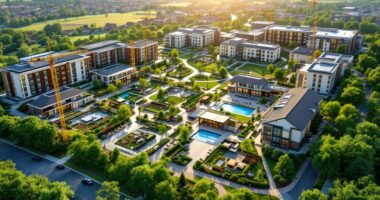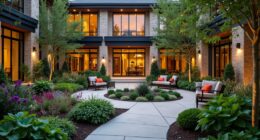In 2025, you'll find retirement communities evolving dramatically to serve 72 million aging Americans through five distinct living choices: market-rate housing with flexible entrance fees, technology-integrated smart residences featuring telemedicine platforms, co-housing arrangements emphasizing social connection, sustainable communities incorporating energy-efficient systems, and personalized service models utilizing AI-driven analytics. With median retirement savings at $202,000, these options prioritize affordability while delivering sophisticated amenities and care solutions. Further analysis reveals how these emerging models address diverse retiree demographics and preferences.

As the demographic landscape shifts dramatically toward 2025, retirement communities are undergoing a fundamental transformation to meet the complex needs of an increasingly diverse senior population that's projected to double by 2029.
You'll find emerging market-rate housing options and co-housing arrangements gaining significant traction, characterized by flexible entrance fee structures and customizable service packages that align with varying income levels and asset portfolios. With a median retirement savings of only $202,000, many Baby Boomers are seeking more affordable living solutions. Residents are increasingly viewing retirement as a time for new opportunities rather than slowing down.
The integration of intergenerational design elements has emerged as a cornerstone of modern retirement communities, with data indicating enhanced socialization outcomes and reduced isolation rates among seniors. Traditional options like independent living continue to evolve with modern amenities and services.
You'll discover innovative partnerships with educational institutions, including grade school adoption programs and university internships, creating dynamic environments that foster cognitive stimulation and meaningful cross-generational exchanges.
Advanced technological infrastructure has become integral to retirement living, with smart home automation systems and telemedicine platforms revolutionizing daily operations.
Smart technology and telemedicine platforms are transforming retirement communities, making daily life more connected, efficient and accessible for seniors.
You'll benefit from AI-driven predictive analytics that optimize care delivery while ensuring operational efficiency, as partnerships with technology providers facilitate sophisticated healthcare monitoring and intervention protocols.
The implementation of personalized service models has revolutionized the retirement living experience, utilizing data analytics to craft individualized care plans and lifestyle programs.
You'll encounter sophisticated volunteer matching systems that align your interests with community engagement opportunities, while integrated social media platforms foster connection and community cohesion among residents.
Environmental sustainability has emerged as a critical differentiator in retirement community design, with facilities incorporating energy-efficient systems and sustainable building materials throughout their operations.
You'll find extensive green spaces and gardening programs that serve dual purposes: promoting mental well-being through nature engagement while advancing environmental stewardship initiatives.
These communities demonstrate a thorough approach to retirement living that balances individual needs with collective environmental responsibility, creating living environments that promote both personal health and ecological sustainability.
Frequently Asked Questions
How Can I Calculate My Expected Retirement Living Costs for 2025?
Calculate your baseline annual expenses, then multiply by 1.04 to account for projected 2025 inflation.
You'll need to factor your current housing costs, utilities, healthcare premiums (typically increasing 5-7% annually), transportation, and discretionary spending.
Incorporate your income replacement ratio (70-80% of pre-retirement income) and adjust for anticipated lifestyle changes, including travel plans or downsizing decisions.
Cross-reference these figures with retirement calculators for validation.
What Medical Facilities Should Be Available Near My Chosen Retirement Community?
Your chosen retirement community should have a thorough medical ecosystem within a 15-minute radius, including an acute care hospital, multiple urgent care centers, and specialized facilities for cardiac and orthopedic care.
You'll need access to both primary care physicians and specialists, pharmacies with 24-hour service, rehabilitation centers, and diagnostic imaging facilities.
Consider communities with on-site medical services and telemedicine capabilities for routine healthcare management.
Are There Age Restrictions for Different Types of Retirement Communities?
Retirement communities maintain specific age thresholds regulated by the Housing for Older Persons Act (HOPA).
In 55+ communities, you'll need at least one resident aged 55 or older in 80% of occupied units.
For 62+ communities, all residents must meet the minimum age requirement, except for caregivers.
Continuing Care Retirement Communities (CCRCs) and senior housing complexes may offer variable age restrictions based on state regulations and community policies.
What Government Assistance Programs Will Be Available for Retirement Living?
You'll find several key government programs to support retirement living, including Social Security benefits averaging $1,905 monthly in 2023.
Medicare coverage for healthcare needs, and Medicaid assistance for low-income seniors.
Additional options include VA Aid & Attendance for veterans, Section 202 Supportive Housing for very low-income seniors aged 62+, and HUD Housing Programs offering affordable living arrangements.
The 2025 COLA increase of 2.5% will boost Social Security benefits for 72.5 million Americans.
How Do I Evaluate the Long-Term Financial Stability of Retirement Communities?
Evaluate a retirement community's financial stability by examining their occupancy rates (aim for 90%+), bond ratings (BBB- or higher), and cash flow statements.
You'll want to review their annual disclosure statements, focusing on debt ratios and Future Service Obligations.
Analyze their capital replacement plans and financial reserves while verifying compliance with state-specific regulatory requirements for cash reserves and financial ratios.









